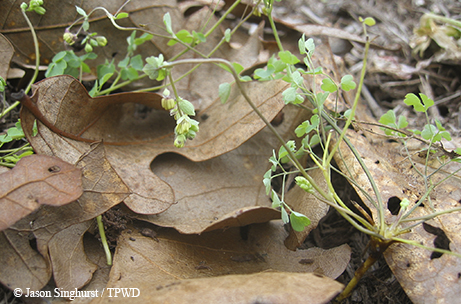
Flora Fact: Little and Low
Get down on your belly to find rare Texas meadow-rue.
By Jason Singhurst
For a botanist, the best days are the ones we spend outdoors, on the hunt for rare plants. It was on such a day that I wandered along a Lick Creek Park trail in College Station through majestic post oaks, blackjack oaks, black hickory trees and prairie openings to a terrace just above the creek, searching for globally rare Texas meadow-rue.
“How hard could it be?” I thought. After all, I was familiar with several of the larger members of the genus Thalictrum, and I had the location of a known population mapped. I was sure I could locate this plant in just a few minutes.
Wrong. After pacing back and forth over a few acres for about an hour, I was ready to give up.
Then it dawned on me: I needed to get down to this plant’s level. Low. Very low.
I got down on my belly, army-style, and slithered around through the sedges and grasses until I got my first glimpse of the purple sepals and yellow anthers of this late winter flowering gem.
“Aha!”

Found in only a narrow strip of the state, Texas meadow-rue (Thalictrum texanum) is a dioecious (separate female and male plants) herbaceous perennial that grows very close to the ground (15 to 35 cm in height) with tiny leaflets.
Currently, six species of meadow-rue are recognized as occurring in Texas. Two of these, purple meadow-rue and waxyleaf meadow-rue, are of widespread distribution in East Texas, while Fendler’s meadow-rue is restricted to the peaks of a few West Texas mountains. Arkansas meadow-rue, another rare species, is limited in distribution to southern Arkansas, southeastern Oklahoma and adjacent northeast Texas. The other eastern species, rue anemone, is known from only Bowie, Lamar and Red River counties in northeast Texas and has only recently been discovered in the state.
Texas meadow-rue (Thalictrum texanum) is a Texas endemic (found only in the state), classified as a plant species of concern. Texas meadow-rue was first documented in Harris County (Houston area) in 1872, and persists in clay-pan post oak savannahs, alluvial bottomland hardwood forest terraces and on pimple mounds in coastal prairies. Populations have been documented at only 10 sites. Texas meadow-rue appears in December and flowers from late January through April. I’ve seen white-tailed deer and several moth caterpillars browse on the foliage.
Texas meadow-rue stems are erect and range from 14 to 35 cm tall. Leaves are generally clustered near the base. The flowers have showy white to purplish sepals, and the 10 to 14 stamens (male flowers) have pinkish filaments. The pistils (female flowers) have pinkish styles/stigmas. The tiny achene fruits range from 3 to 4 mm.
Another population can be seen at Stephen F. Austin State Park in Austin County. A new population of Texas meadow-rue was found in Washington County last year; the TPWD Wildlife Diversity Program is interested in finding additional populations of this rare plant.
So look low to the ground and maybe you’ll find a new population of Texas meadow-rue. Please tell us if you do!
Common Name Scientific Name Size Did you know? |
» Like this story? If you enjoy reading articles like this, subscribe to Texas Parks & Wildlife magazine.
Related stories

